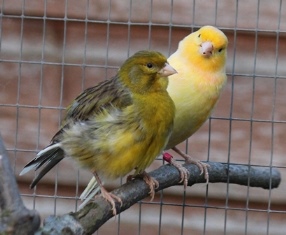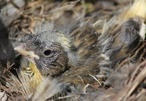|
The Birds - Canaries
Canaries - facts & figures
Canary - Description
They feed on everything available and from anywhere! They are
primarily seed eaters but are to be found in the pots as often as on the
ground foraging. They were the first to start chewing on corn cobs when
we introduced them and will join the quail and peck away at dandilion
leaves when we provide them. They also eat seedlings as they sprout up
as well as fruit and mealworms. They were also quick to build nests and lay eggs. One pair did not manage to hatch out their clutch in time, the other did. They eventually nested in cups but also tried seed pots, commandeering the abandoned nests of others before finally building their own - an olive tree being one of their favoured spots. We have no idea what variations we have and are not interested in this side of canaries. It has always seemed odd that people should latch onto a bird that has the name of a dog but seeing how easy thay are to keep and breed and how inclined they are to sing, I can see why they have become popular. However, you just have to do a search for canaries on the internet to find a number of sites gushing drivel about their care to see why we were not enthusiastic before. As a community bird, they are ideal. They are hardy, do not trouble others and have shown no signs of stress themselves. | |||||||||||||||||||||||||||||||

 We had never considered added canaries to our community. They seemed commonplace and not exotic.
However, we have come to enjoy their industry and, especially, their
song. Ours may not be prize birds and we may have bought them just to
give them a good home but they have given us pleasure .
We had never considered added canaries to our community. They seemed commonplace and not exotic.
However, we have come to enjoy their industry and, especially, their
song. Ours may not be prize birds and we may have bought them just to
give them a good home but they have given us pleasure . 